I wrote this when New Horizons was approaching Pluto, and expected to find new moons and possibly a ring system. So, just as a fun question to hook this post on, I asked, could it find a moon of a moon? Or a moon with rings?
As we know now, it didn't find any new moons at all, a great surprise to the team. Its moons had interesting chaotic spins and when imaged close up, they are all elongated, and Hydra might be a double-lobe object perhaps formed in a gentle collision, like Comet 67p. And Kerberos certainly seems to be a double-lobe object. But there were no new moons found, and certainly no moonlets of moons or rings of moons.
I've added an update section, but thought I'd leave the rest as it was before the Pluto discoveries.
The question is still open. Can a moon have moons? Of any size, even tiny ones of perhaps a few tens of meters across?
As we search for an answer, we will find out about why our Moon finds it hard keep any satellite at all, even just for a few years, and why an early satellite released by Apollo 16 unexpectedly crashed into it. Also we'll chase up an intriguing puzzle about Saturn's moon Rhea. And investigate the mysterious equatorial ridge of Iapetus.
Let's start with our own Earth / Moon system. Why is the Moon's orbit stable, and why can't our Moon have moonlets? Or can it?
OUR MOON IS NEVER ABLE TO CATCH UP WITH ITS OWN TIDES
Our Moon constantly spirals outwards, currently by 3.8 cms a year. The reason, as it turns out, is because its month is longer than our day and because of tidal lag.
If the tides could respond instantly, so that you got the highest tides when the Moon is exactly overhead, they would have no noticeable effects on the orbit of the Moon.
Also, if the Earth's surface never changed shape at all, like a steel bearing, say, again there would be no tidal drag. But for something as big as the Earth of course that is totally impossible; no natural material is as strong as that.
So, instead, the tides lag just a bit behind the Moon in its daily apparent motion across the sky from East to West. That's what it seems like to us, the Moon crosses the sky first, then the high tides follow afterwards. But from the point of view of the Moon, the tides are actually always a bit ahead of the Moon in its orbit around the Earth from West to East, and it never quite manages to catch up with them.
If you find that confusing, it's no surprise. This diagram may help.
Drawing credit Andrew Buck The tides of course are hugely exaggerated.
This is the view from above the North pole. For someone on the globe at the equator at the top of the picture next to the arrow, East is to left of this picture, and North is out of the picture, pointing towards us.
The Earth is spinning right to left (from West to East). The Moon is orbiting in the same direction but much more slowly.
From our vantage point on the rotating Earth, because Earth spins faster than the Moon orbits, we see the Moon traveling the other way, from East to West (left to right in the picture), rising and setting like the sun. Though you will also see that every day it rises and sets nearly an hour later in the day, because of its eastward drift against the night sky. To see how it drifts in time like this, see for example moon rise and set times for New York. Each day it rises nearly an hour later.
So from our vantage point, the tides seem to lag behind the Moon - the Moon passes overhead first, and the highest tides follow later on in the day.
But as far as the Moon is concerned, it is actually orbiting us slowly in the opposite direction from what you might think, West to East (right to left in the picture). So, the tides on the much more rapidly spinning Earth are actually always ahead of it, and it never quite manages to catch up with them.
You get tides in the solid Earth too, tiny tides; they raise the land by about 30 cms or so. These are much more regular than sea tides. And you can measure their lag by satellite. They lag behind the Moon by a rather small amount, about 0.12 to 0.13 degrees.
Sea tides along coastlines lag much more, due to resonances in the oceans. The average tidal lag is six hours. So, often you find you get low tide when the Moon is at its zenith, the opposite of what you'd expect. See Currents and Tides. This depends on local coastal conditions - sea tides are extremely complex depending on the coast, seas, islands, underwater features etc. There are many places with one high tide a day and other places with more than two high tides a day. For more on this, see We get Moon Tides, but What About Sun Tides?
OUR MOON'S OUTWARD SPIRAL
These tidal forces from the faster spinning Earth pull the Moon in the same direction it orbits us. This pulls it into higher and higher orbits around the Earth. While at the same time the Moon tugs on the Earth tides in the opposite direction, which slows down the Earth's spin rate.
Surprisingly, this forward pull of the tides on the Moon in its orbit causes it to slow down rather than speed up. This is probably the opposite of what you'd expect.
The tides, by pulling it forward, pull it into a higher orbit, and higher orbits have less velocity relative to the Earth. The Moon's orbital velocity is only 1.022 kilometers per second relative to Earth compared to the ISS velocity of around 7.66 kilometers per second.
Aside about orbital mechanics
Orbital mechanics is a bit unintuitive sometimes. If you have a rocket in low orbit around the Earth, the same height as the ISS, say, or lower - and you want to get it up to the much higher geostationary orbit, you accelerate it in the direction of its orbit around the Earth.
You'd think this would make it orbit more quickly, but no, even though you accelerate constantly in the direction of motion around the Earth, it actually goes into a higher orbit, and so slows down relative to Earth. A satellite in GEO moves at 3.07 km/sec relative to the Earth while the ISS in its lower orbit moves at around 7.66 km/sec
So, even the Moon's orbit is not totally stable; it keeps changing like that, getting slower and higher.
Eventually - as the Earth slows down its spin, then if you could leave that for long enough, the Earth and Moon would become synchronous like Pluto and Charon each facing the other but at a huge distance apart. That is, if they survive the red Giant phase of our sun.
And then - if they continue to survive the Red Giant phase of our sun five billion or so years into the future, then over immense periods of time, under the influence of the tidal effects of the sun, also the friction of gas expelled from the sun, the system continues to evolve further. There are differing ideas about what happens next, but one possibility is that the rotation speeds up again, and the Moon spirals in - the whole system losing energy in the process and eventually the Moon hits the Earth, at which point the Earth is spinning rapidly much as it did when the Moon first formed.
Anyway. so even the Sun / Earth / Moon system is not stable long term but is evolving, and eventually either the Moon would hit the Earth or the Earth and Moon end up tidally locked to each other for billions of years.
But it is stable over the billions of years that have elapsed so far.
The Moon spirals outwards because its orbital period, the lunar month, is longer than the Earth day. If the lunar month was shorter than an Earth day. the tides would tug it forward in its orbit, bringing it down to a lower, faster orbit, and so it would spiral inwards, and eventually hit Earth. Exactly this is happening right now to Mars' innermost moon Phobos, which will eventually hit Mars.
MOONLETS OF THE MOON WOULD SPIRAL INWARDS, AND HIT THE MOON UNDER INFLUENCE OF TIDES - BUT THIS IS A VERY SLOW PROCESS FOR TINY MOONLETS
A moonlet orbiting the Moon has to orbit really close to it, as the "Hill sphere", the furthest away it can get and not be captured by the Earth, is just 60,000 miles above the surface. So our moonlet will orbit far faster than the Moon's 28 day rotation period. Typically, it orbits the Moon every couple of hours or so.
This movement will set up tiny tides in the Moon, through the gravitational tug of the satellite. And those in turn will pull back at the satellite, instead of forward, because the tides can't keep up with the fast orbit of the satellite around the Moon and lag behind it.
So that then has the effect that the satellite gets faster and faster (the same paradoxical thing as before, pulling backwards on the moonlet this time pulls it into a lower orbit with a faster period) spiraling in towards the Moon and eventually it hits it.
However, tidal effects are much less for small objects. As you can imagine, the tides raised by a tiny moonlet, say of a few tens of meters diameter, or an artificial satellite, are tiny, and have little effect on their orbit.
So though if you do a web search you'll find many posts and even articles by people saying that the reason the Moon hasn't got natural satellites is because of tidal effects - actually that's not the main reason at all. Not for small ones anyway, though it does rule out any large satellite.
There is another effect that makes it really hard for the Moon to capture a satellite, even a tiny one. Our Moon would be unable to keep even the smallest natural satellite, for more than a year or two, usually, and sometimes it can't keep a satellite for more than a month. That can't be anything to do with tides.
THE REAL REASON WHY LUNAR SATELLITES AND MOONLETS CRASH INTO THE MOON
This was first discovered in April 24, 1972. The Apollo 16 astronauts tried to put a small satellite called PFS-2 into a two hour lunar orbit. The crew of Apollo 15 had already done this successfully with an earlier satellite PFS-1, which had been orbiting the Moon just fine for eight months. Both started in similar orbits, ranging from 55 to 76 miles above the surface.
But - to their surprise, PFS-2's orbit rapidly changed shape. Within two and a half weeks, it was swooping down to within 6 miles of the surface. After a while it backed away again to 30 miles from the surface, but eventually, only 35 days after it was released, it hit the Moon.
The real reason that moonlets can't form around our Moon are because of the Mascons - the concentrations of mass on the Moon.
This figure shows the mascons on the near side of the Moon in orange red.
As the satellites orbit the Moon their orbits are tugged one way and then the other by the Mascons, and these keep changing the shape of the orbits. They don't make them spiral down - it's not a tidal effect. Instead, they make them sometimes more elliptical, and sometimes more circular, somewhat randomly. Most orbits around the Moon will eventually become so elliptical they intersect the surface of the Moon and the moonlet crashes.
"FROZEN ORBITS" OF THE MOON
Some orbits are more stable. PSF-1 lasted for a year and a half, before it hit the Moon.
And there are a few "frozen orbits" where a spacecraft can orbit the Moon indefinitely. So those are good for mission planners who want to keep their spacecraft in orbit around the Moon for a long time without using a lot of fuel. But it would be hard for a natural satellite to get into them.
The NASA page: Bizarre Lunar Orbits says:
"There are actually a number of 'frozen orbits' where a spacecraft can stay in a low lunar orbit indefinitely. They occur at four inclinations: 27º, 50º, 76º, and 86º"
So, it's the irregularity of density of the Moon that's the main factor here. The tidal effect isn't that important over reasonable timescales for small moonlets. After all even the Moon's orbit is not stable indefinitely, over billions of years, due to tides but that doesn't stop Earth having a Moon.
So depending on the shape of the moon, and whether it has mascons, and how small the moonlet is, a moon could have stable moonlets for at least some period of time.
So let's look at this a bit closer
SOME ASTEROIDS HAVE MOONS TOO
Although we don't know any moons with moonlets, some asteroids have them and some even have two. Could an asteroid with its own moonlet perhaps be captured by a planet without losing it? Let's take a closer look at the asteroid moons.
These are sometimes referred to as Moonlets. In this answer, I thought I'd use that word for moons of moons as well, to make it easier to keep track of which are the moons and which are the moonlets in the discussions.
The word moonlet is sometimes used for small normal moons, e.g. moonlets orbiting within the Saturn ring system, but we won't be discussing those, so hopefully this isn't too confusing. Scholarly papers sometimes call them "sub satellites", but that seemed a little clumsy.
This is Ida, first asteroid with its tiny moonlet Dactyl, the first asteroid moonlet ever found. Photo taken by Galileo spacecraft in 1993
The consensus seems to be that Dactyl was probably formed in the same event that created Ida, about 1.5 billion years ago. Unfortunately, Galileo passed Ida almost exactly in the plane of Dactyl, which made it almost impossible to pin down an orbit for it exactly.
As you can see, Ida is irregular in shape, and so, rather like satellites of our Moon with its irregular mass distribution, the orbits of Dactyl are complicated. Depending on your assumptions, you can end up with a chaotic orbit that never repeats exactly and lasts for 1.5 billion years. Or you may find with other assumptions that it escapes within a year, or impacts on Ida. Or you can find it is in a resonant orbit that repeats pretty much exactly throughout that time. See the long term dynamics of Dactyl's orbit for techy details with plots of example orbits.
This is 87 Sylvia, the first asteroid found to have more than one satellite. Its second satellite was discovered in 2004.
ASTEROID WITH RINGS
An asteroid can also have a ring system as well. This was a spectacular discovery in 2014 of the Rings of Chariklo. The rings are thin, and would be really bright to the naked eye if you were standing on the asteroid.An artist's view of the rings surrounding the asteroid Chariklo, which is only 125 kilometers in radius, and the rings are around 400 km in radius.
Credit: Lucie Maquet
Asteroid Found with Rings! First-of-Its-Kind Discovery Stuns Astronomers (Video, Images)
So, that suggests we can widen the question and ask, not just, can a moon have moonlets - can it have rings also?
WHAT IF WE HAD SYLVIA WITH ITS TWO SATELLITES IN ORBIT AROUND EARTH INSTEAD OF THE MOON?
Suppose that, somehow instead of our Moon, we had 87 Sylvia, orbiting at the distance of the Moon. Would it be stable? It's easy to find out, as you just need to calculate the Hill radius, and there's a simple formula for that (this is for the simplest case of a circular orbit; the formula is a little more complex for an elliptical orbit). I'll indent all the calculations here, to make them easy to skip if you aren't interested in the details:Calculation:
where r is the radius of the Hill sphere, a is the semi-major axis of the moon's orbit, m is the mass of the moon and M is the mass of the planet.
So, in case of 87 Sylvia, orbiting at the distance of the Moon, then m=1.478*1019 kg.
M = mass of the Earth = 5.97219 * 1024 kg
a = distance of Moon (semi-major axis) = 384,400 km
so r = 384,400* cube root (1.478*1019 / (3*5.97219 * 1024))
= 3605 km.
(BTW its diameter is 286 km).
So the Hill radius of Sylvia, if we had it in place of our Moon, is 3605 km.
Sylvia's moon Remus orbits at 706.5 km, and Romulus orbits at 1357 km. So both are well within its Hill sphere. So the system would be stable if it was located in place of our Moon.
THIS SHOWS THAT YOU CAN HAVE A MOONLET OF A MOON AT LEAST IN THEORY
So - it is clear that you can have a moonlet of a moon. If our Moon was replaced by Sylvia it would be stable over long periods of time just like Sylvia itself.
So - the main thing is - not whether they can exist - but if they can possibly form in our solar system. For instance how would an asteroid be captured around a planet, and do so without losing its moonlet? Or might the capture process (say a collision) actually create a moonlet?
One way a large moon can be captured is by binary exchange capture. For instance if a planet the mass of Mars has a moon the mass of Mercury, and it encounters Jupiter, then through tidal disruption, the Mercury mass object can be ejected, leaving the Mars mass object in orbit around Jupiter. See Capturing Terrestrial Moons. But this process might well disrupt any other moons or rings in the system.
Does anyone reading this know of any studies of interactions of planets with a system of moons, perhaps with a large outermost moon - can any of the more tightly bound moons survive the tidal interaction and end up as a moonlet?
Or can they form through collision processes?
We will see later that the intriguing mystery of Saturn's moon Rhea lead to some
WHAT ABOUT A MOONLET OF A MOON AROUND VENUS?
Could there be a tiny asteroid with a moonlet in orbit around Venus for instance, undiscovered? It seems an obvious place to look, similar size to the Earth.
If it rotated as fast as the Earth it could easily hold onto a moon as big as ours. But it has a very slow rotation period, only once every 243 Earth days. So there is no way it can have a moon far enough away to spiral outwards rather than inwards. The tidal effects of Venus on any moon will always pull it inwards.
Even if it was hit by a big body that created a Moon like ours in the early solar system, then - long ago it would have spiraled in and hit the surface of Venus. Some planetary scientists think that exactly that might have happened
But a smaller moon could have survived for billions of years, because tidal effects lead to much slower rates of decay of the orbit for smaller moons. The researches calculated that Venus would need to have a moon less than a few kilometers in diameter to survive right up to today.
There was a search in 2009, which surveyed it down to 0.3 Km and didn't find any moons. Page on ciw.edu. In any case a moon that small would be low mass (far smaller than 87 Sylvia and have a tiny Hill sphere.
WHERE TO LOOK FOR MOONLETS OF MOONS
I suppose it depends how these moons form. If they form by collision, what you want is a tiny moon orbiting a long way away from a planet, and then hit by another moon so that a cloud of debris flies into space and then forms a moonlet about it.
The asteroid moonlets may well be just loosely clumped together piles of boulders, as may be the asteroids themselves also, these tiny ones like Ida and Dactyl - with such low gravity they don't need to be held together strongly, may be more like loose rubble piles.
So if you have a place with lots of collisions happening, seems a place to look for moonlets.
So that's something that could well happen I think some distance away from any of the larger planets.
SATURN AS A GOOD PLACE TO LOOK WITH SO MUCH DEBRIS IN ORBIT AROUND IT
If the moonlets form by collision, then you want a planetary system where there is a good chance of moons to hit each other or materials to hit the moons. And for that - well I'd say the Saturn system is a good bet. If we do find a moon with a moonlet, maybe we'll find it there?
Here is one of the moons of Saturn, Prometheus
Saturn's Rings and Moons are Solar System Antiques
It's got numerous moons. So is quite promising. But none of them have confirmed moonlets, yet discovered, sadly. But it does get quite close. First the co-orbital moons:
CO-ORBITAL MOONS
It does have co-orbital moons Epimetheus and Janus.
This is not a double moon though it may seem so from this photograph.
Instead, they are co-orbiting and swap orbits. It is what can happen to what would otherwise be a moonlet of a moon, when the Hill sphere is too small to include both objects. So I think it is worth going into, it also helps to explain what the Hill sphere is all about.
Suppose for instance that Epimetheus is on the inside, as happens every 8 years, and Janus on the outside. Then Epimetheus is orbiting just 30 seconds per orbit faster than Janus. So it gradually gets further and further ahead of Janus until, four years later, it starts to catch up with Janus from behind.
When it does that, then Epimetheus pulls backwards at Janus - which causes it to go faster and drop into a lower orbit. Meanwhile Janus pulls forward at Epimetheus causing it to go slower and into a higher orbit. So then they swap places. Now Janus is on the inside, and Epimetheus is on the outside, and Janus will gradually speed away and so it goes on like that, swapping positions every four years. See Epimetheus (moon)
This gives a rough idea of how it works:
The main difference is that in that video, the green one is much heavier so its orbital radius doesn't change. In the Saturn system, whenever the white one moves inwards in its orbit, the green one moves outwards, and vice versa. But otherwise it is just the same.
Here is another view this time in 3D, using rotating frame:
More about it here: The Orbital Dance of Epimetheus and Janus. That page includes a short video taken by the Cassini orbiter in 2005. It shows Janus and Epimetheus at the moment they change orbits (though it's taken from within the plane of the orbits, and by a spacecraft which is itself also orbiting, so it is not so easy to see what is going on).
Here BTW is a simulation of four moons co-orbiting, something which could happen theoretically though no examples known, this is in rotating frame
HORSESHOE ORBITS - THE CASE OF EARTH AND CRUITHE
It's related to the idea of a "horseshoe orbit", like the much more complex orbit of 3753 Cruithne which is in a "bean shaped orbit" relative to Earth.
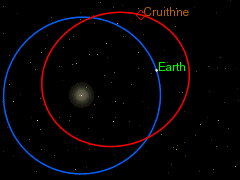
Or in a rotating frame, from Earth's perspective
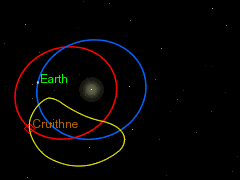
But something you don't see in that animation, that "bean" is also gradually drifting around relative to Earth until it catches up with Earth from behind, similarly to Janus and Epimetheus - and then when that happens, then the Earth and 3753 Cruithne do a similar swap except this time because of the difference of size, 3753 Cruithne moves over half a million kilometers while Earth moves just 1.3 centimeters.
Nevertheless that swap will move the Earth outwards a bit, enough so that your year is a little longer from then onwards, until next time the swap happens. Then it swaps back again and the process repeats. The whole process takes around 770 years.
So anyway you can get co-orbiting moons, though they are rare. So far we have only one known example in our solar system.
WHAT ABOUT OTHER MOONS OF SATURN?
Saturn has numerous moons, wikipedia lists 62 so far. Outermost is Fornjot (moon) orbiting at a distance of 24,504,879 km from Saturn.
At six kilometers in diameter, it's a little small, though many NEOs are smaller than that and have moonlets.
But let's take the case of Phoebe (moon), the outermost moon of any size. It is also prograde - rotating Saturn in opposite direction to the planet's rotation. And has a fast rotation period of 9 h 16 min 55.2 secs
Calculation:
m=8.292*1018 kg (mass of Phoebe)
M = mass of the Saturn=5.68319 * 1026 kg
a = semi-major axis of Phoebe= 12,955,759 km
so r = 12,955,759 * cube root(8.292*1018/(3*5.68319 * 1026))
= 21950.5 km.
So its Hills radius of 21,950.5 km is easily large enough for it to have a few moonlets like 87 Sylvia. Phoebe's diameter is 200 km (radius 100 km).
It is highly non spherical
But on the other hand it is really tiny, radius only 100 km. It's not like an orbit at say 15,000 km away is close to its surface and going to be diverted into elliptical orbits as happens with the Moon. And Ida is very irregular also and has a moonlet.
So, could it have a tiny moonlet, orbiting up to 20,000 km away or so? Would it have been spotted if it had one?
Another obvious place to search is Titan.
m = 1.3452*1023 kg (mass of Titan)
M = mass of the Saturn=5.68319 * 1026 kg
a = semi-major axis of Titan= 1,221,870 km
so r = 1,221,870 * cube root (1.3452*1023/(3*5.68319 * 1026))
= 52,406 km.
Its radius is 2,576 km. So a Hills radius of 75,582 km gives a fair bit of room for a tiny moonlet.
Since it is also highly spherical that might seem promising.
But it is tidally locked with Saturn, with a slow rotation of 15.945 days, and another factor that could count against moonlets, it may have a subsurface ocean which could lead to stronger tidal effects.
Still it would seem promising for a tiny moonlet or ring. Though I've not seen any suggestion that it could have moonlets or rings.
ONE OF THE MOST PROMISING PLACES TO LOOK, RHEA
One promising candidate is Saturn's moon Rhea, its second largest moon and a long way from the planet, and at one time it was thought to have a ring system, with most of it within its Hill sphere. If this was true, it would be the only moon known with a ring system, which you could think of as lots of really tiny moonlets. This then would prove that in practice it is possible for moons with moonlets or rings to form.
Artist's impression of the rings of Rhea
And this shows where it is relative to the rings and the other moons - a long way out though not as far as Titan:

One idea for how they might form was an impact into Rhea which would throw up gas and solid particles, and then once the gas dispersed, the remaining particles would form the rings. Numerical simulations showed that these rings could be relatively long lived, last at least a million years. Rhea is prolate - elongated towards Saturn. But this seems to be no problem for ring formation in simulations.
See also Saturn's moon Rhea may have rings, too.
Sadly, later observations to try to confirm this found no evidence of any ring system. "A very sad story": No rings for Rhea after all
But the jury is still out as to whether it had a ring system in the past, because it has these intriguing blue marks all around its equator, which may be the marks of de-orbiting ring material:
The search also didn't rule out a ring of objects larger than 8 meters in diameter, but a ring like that would normally be accompanied by smaller objects created through collisions. Very small particles could be swept out by electromagnetic forces, but ones of intermediate size, meter and centimeter in scale, would be detected. They concluded that neither a ring of objects larger than the detection limit of their method, or smaller, was likely.
Also they didn't rule out any ring system. They just ruled out any ring system dense enough to explain the magnetospheric observations. It could still have a sparse ring system.
For instance, they mention that the cosmic dust analyser found dust particles close to Rhea at a density of one particle of at least one micron in diameter every two thousand cubic meters - and this is well below the detection limit of their measurements, so it seems likely that Rhea does have an associated thin dust cloud. Their detection methods could also miss larger particles of all sizes up to at least a hundred meters radius associated with it, if the number density of the rings was low.

In this diagram, their methods permitted low densities of particles of all sizes in the green area of this diagram - but showed there weren't enough to account for the electron absorption measurements of Cassini in the red area.
So they haven't ruled out all possibilities of rings around Rhea - just showed that if it has rings, they can't be very dense. And indeed Cassini did directly detect an increased number of smaller micron sized dust particles in the vicinity of Rhea. So it probably has an associated dust cloud, at least.
For the techy details, see Cassini imaging search rules out rings around Rhea.
If Rhea does have a ring system, then just like Saturn it might have a shepherding moonlet outside of it helping to keep the material in place around the moon.
Rhea is a particularly good candidate because it is a near spherical moon (so not got the problem of irregular shape) - so if it doesn't have Mascons like the Moon, orbits could be very stable around it. And though tidally locked with Saturn with a period of 4 days, it is not likely to have significant tidal effects on a tiny moonlet unless it has an underground ocean.
Let's do our Hill sphere calculation for Rhea for completeness
Calculation:
m=2.306518*1021 kg (mass of Rhea)
M = mass of the Saturn=5.68319 * 1026 kg
a = semi-major axis of Phoebe= 527,108 km
so r = 527,108 * cube root (2.306518*1021/(3*5.68319 * 1026))
= 5829.7 km.
So its Hill sphere radius is 5829.7 km
Rhea's radius is 763.8 km.
Rotation period (synchronous so same as orbital period) 4.518212 days
So anyway - whether Rhea does turn out to have a ring system or not, and whether or not it turns out to have a shepherding moonlet, in the modeling they did for the ring system, they did work out the physics of it all and showed that such a system could be stable over the duration of the solar system.
So the answer is a definite YES, in theory, moons can have moonlets, and even rings!
None are known for sure yet, but there is a distinct possibility that Rhea at least might still, some day, be proved to have a tiny moonlet or even a sparse ring system.
IAPETUS - DID IT LOSE ITS RING OR MOON?
Saturn's moon Iapetus is best known for its dark leading hemisphere. One side is as dark as coal (albedo 0.03 to 0.05), the other side is nearly as bright as snow (albedo 0.5 to 0.6, snow has albedo 0.4 for melting snow to 0.9 for freshly fallen snow). Which may be hydrocarbons welling up from its interior, or it could be it gathered up material shed by Saturn's next further out moon Phoebe.
But it has one other very surprising feature, this remarkable equatorial ridge
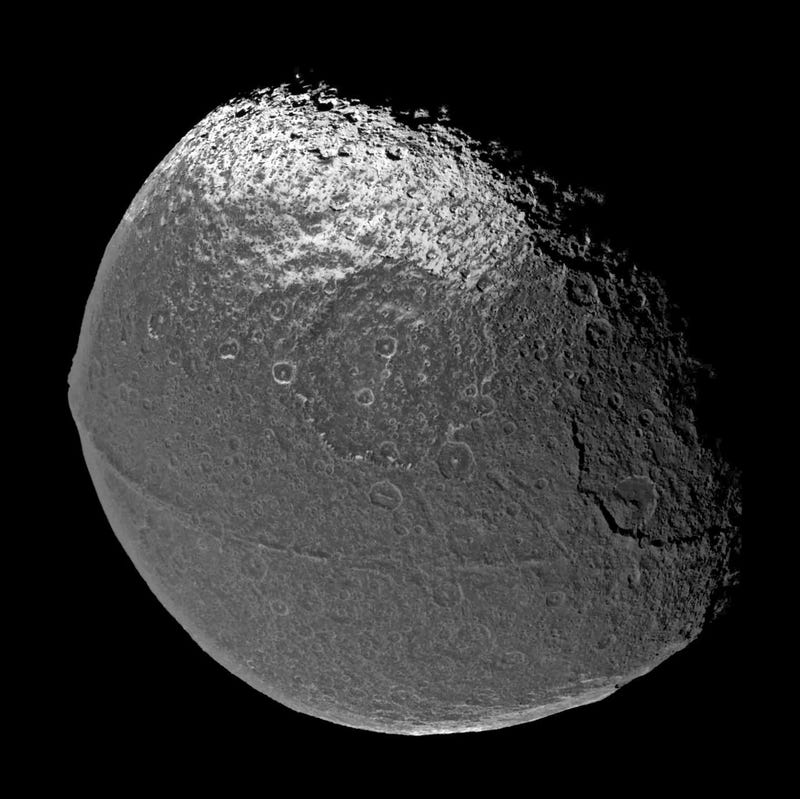
One of many suggestions for how it could have formed is through collapse of a system of rings. Which could have originated as a distant sub-satellite. They estimate that a large sub satellite could be stable for between 100,000 years and a billion years around Iapetus depending on whether it formed close or far from it originally. It would decay after the initially rapidly rotating Iapetus despins due to tidal interactions with Saturn. As it orbited closer to Iapetus, the tidal forces would tear it apart to form a ring, and then the impact of the ring particles would form the equatorial ridge.

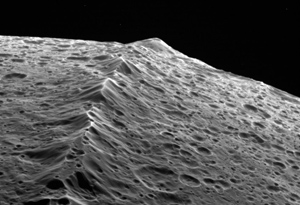
Close up views of the equatorial ridge of Iapetus.
Flyover of its ridge
This is one of several theories about its origin.
Other moons of Saturn could also have rings or moons, but the orbital stability limits are largest for Iapetus. Also Iapetus is one of a few that can have a satellite orbiting outside of its Roche limit - meaning it could have a large intact satellite originally. For the others, any satellite would need to be very small or it would already be disrupted as a ring system. Callisto, Titan and Oberon are other ones with large stability regions for sub satellites.
Figure 5 from their paper. The white area with shading at the bottom shows the Roche limit of about 2.5 times the radius of the satellite - any large sub satellite (moonlet) inside this would be tidally disrupted. The lines show the orbital stability limits. Iapetus has the largest stability limits of all the satellites.
The space artist Ron Miller has done some fine artist impressions of this idea of rings of Iapetus for his io9 article on the topic.
DECAY OF MOONLETS
Though the paper calls them "sub satellites" I'll call them moonlets instead here as with the rest of this post.Eventually large moonlets will decay through tidal interactions with the moons, so long as they orbit the moon at faster than its spin rate. Most moons spin slowly, and are often tidally locked with their planet.
Most of the moonlet orbits would decay through tidal effects within sixteen million years. The two exceptions are Iapetus and Oberon. A moonlet of Oberon could survive for a billion years. A moonlet of Iapetus could, in best case, last for more than the age of the solar system.
This is their figure 6. The closed circles are for retrograde orbits around the moons, and the open circles for prograde orbits. The moons are the same as for figure 5. Iapetus is by far the most stable - outermost of the moons of Saturn in this list. A large moonlet of Oberon, moon of Neptune, is also much more stable than the other ones though it couldn't last to the present day.
Oberon is an interesting one to have turned up as the other possible moon with an equatorial ridge. It was observed by Voyager 2, but we couldn't see its equatorial region. So - it also could have an equatorial ridge and we wouldn't know about it.
For more on all this, see also Emily Lakdawalla's "Iapetus' peerless equatorial ridge" .
From their calculations, a large moonlet of any of those satellites would have to have formed recently to still be present in our solar system.
As with the search for moons of Venus, a very small moonlet, of just a few meters in diameter would not be affected by tides in the same way so could survive. They were interested only in large moons large enough to form a ring system and an equatorial ridge when it decays.
Could Iapetus have a very tiny moonlet to this day? Their calculations show that even large moonlets could be stable (but we know it no longer has a large moonlet). So a tiny moonlet of tens of meters diameter, say, would be even more stable.
If it is worth searching Venus for tiny moons - might it be worth a search of Iapetus for moonlets?
WHAT ABOUT THE PLUTO SYSTEM
This is topical with New Horizons doing a flyby mid July 2015. Might it discover a moonlet of a moon?
(I wrote this before the flyby, update section follows after).
It would seem quite promising if moonlets are created by collision, since it's moving rapidly in the Kepler belt and gets hit often with high speed collisions, and has many moons already discovered.
Also its many moons may have formed from a ring system, like Saturn, and it may still have rings. This is result of one recent simulation into the possibility of rings of Pluto.
Ring System Around Pluto?
Notice that the binary system in the middle clears out the central part of the ring, but beyond that, the orbits are circular.
First colour image of Pluto and Charon taken by New Horizons.
Let's do our Hill sphere calculation for Charon first
Calculation:
m = 1.52*1021 kg (mass of Charon)
M = mass of the Pluto =1.309 * 1022 kilograms
a = semi-major axis 17,536 km
so r = 17,536 * cube root ( 1.52*1021/(3*1.309 * 1022))
= 5931.9 km.
So its Hill sphere radius is 5931.9 km.
Charon's radius is 603.5.
Rotation period 6 d, 9 h, 17 m
Compare Rhea:
Its Hill sphere radius is 5829.7 km
Rhea's radius is 763.8 km.
Rotation period (synchronous so same as orbital period) 4.518212 days
They are almost exact clones in terms of both size and Hill sphere.
So it would seem that if Rhea can have a ring system, possibly even a moonlet to shepherd it, then Charon could too, at least on the basis of its Hill sphere radius. Though I can't find any suggestion of this as a possibility in the articles I read.
Let's also try Hydra, Pluto's outermost of its known moons:
Hydra (moon)
Calculation:
m = 4.2*1017 kg (mass of Hydra)
M = mass of the Pluto =1.30900 * 1022 kilograms
a = semi-major axis 64,749 km
so r = 64,749*cube root( 4.2*1017/(3*1.309 * 1022))
= 1426.6 km.
So its Hill sphere radius is 1426.6 km.
Hydra's radius is 61 to 167 kilometers
Rotation period unknown
It is similar in size to Ida, possibly larger. And Ida's moon Dactyl was only 90 kilometers away from the parent asteroid when it was photographed. Dactyl's orbit is unknown, so could be elliptical or circular.
But since then many asteroids have been found to have moons, at various orbits from less than a kilometer to over a thousand of kilometers from the parent. Even the most distant in that table, the Petit Prince asteroid of Eugenia - first moon of an asteroid to be discovered from Earth - has an orbit of 1184 as its semi-major axis so could just fit inside the Hill sphere radius of Hydra.
So, it would seem that Hydra could easily have a moonlet like Ida, in theory at least.
243 Ida's moon Dactyl
Pluto has several other tiny Moons now known, Kerberos and Styx have been added to the list.
Pluto: Moons
Kerberos is even more double moon-like, very like Comet 67p.

Calculation:
m = 1.65×10^16 kg (mass of Kerberos)
M = mass of the Pluto =1.30900 * 1022 kilogramsMass ratio: 0.00000126
a = semi-major axis 58,000 kmso r =58,000*cube root( 0.00000126/3) = 434 km.
So, it's Hill radius is 434 km. A lot smaller than Hydra, but Kerberos is smaller too, 19 × 10 × 9 km
UPDATE ON PLUTO'S MOONS
The first surprise actually came over a month before the flyby. Using Hubble observations, scientists found that Pluto's moons tumble chaotically. Like Hyperion. This is a numerical simulation of how Nix rotates. You wouldn't know, many days in advance, where in the horizon the sun is going to rise or set over, if you lived on Nix. It's the same for the other moons of Pluto.
Then, the moons have orbital resonances, a bit like the moons of Jupiter. but unlike the Jupiter system, they are in different positions relative to the barycenter when they lap each other, each time the resonance repeats.
You can explore this with the NASA's Eyes computer program.
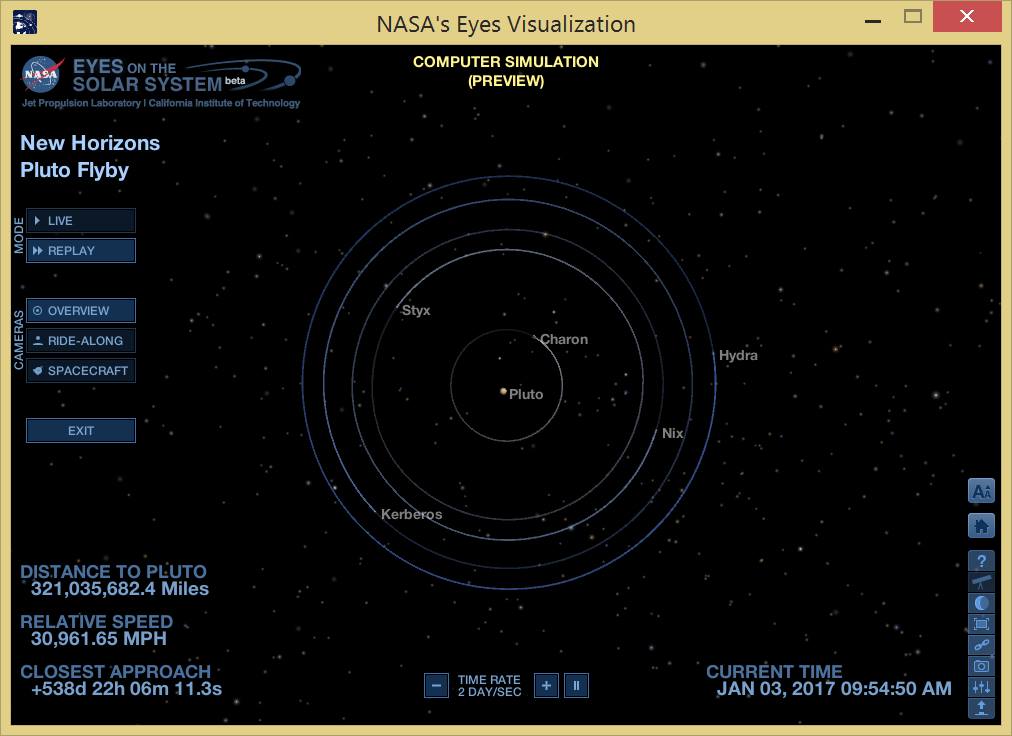
This is from a paper that was published just one month before the encounter, by Mark Showalter as the principal author, Resonant interactions and chaotic rotation of Pluto’s small moons
He summarizes his main finding about their orbits as “If you lived in the Pluto system and were sitting on Nix, you would see Hydra go around three times every time Styx goes around twice,” (see news item about his discovery in Nature).
Details of their findings about the resonant orbits: the resonance is phi = 180 degrees = (approx) 3 s - 5 n + 2 h where s is the angular position of Styx, n is the angular position of Nix and h is the angular position of Hydra, all as measured from the barycentre of the system.
There the angle phi will librate back and forth but is close to 180 degrees. It slowly decreased from 191 degrees to 184 degrees during 2010–2012 which is consistent with a slow libration about 180 degrees. This is a large amount of libration compared with the Jupiter system libration of 0.03 degrees, but larger librations are known, e.g. the system of exoplanets around Gliese 876 librates by about 40 degrees.From which you can deduce that every three times Nix laps Hydra, then Styx laps Nix twice. (Using analogy of runners lapping each other on a racetrack).
Then there is another resonance involving Kerberos.
180 degrees = (approx) 42s - 85 n + 43 k
From which it follows that every 42 times Nix laps Kerberos, then Styx laps Nix 43 times.
But unlike the Jupiter system resonances, where the pattern repeats exactly, they are in different positions relative to the barycenter when they lap each other, each time the resonance repeats.
It was already known (since Nix was discovered in 2011) that they are all in a near 1:3:4:5:6 resonance with Charon - but this is not exact. It may have been an exact resonance in the past if Charon's orbit was originally more eccentric.
They also concluded that because of these orbital resonances, any other moons between Styx and Hydra would be unstable unless they were co-orbital with the ones already known - i.e. two moons sharing an orbit and sometimes overtaking each other.
Apart from that, the only stable positions to find extra moons would be co-orbital moons with the ones already known or inside Styx or outside Hydra.
So after that paper, which was published a month before the encounter, new moons became less likely.
We now have images of three of the moons. First, Nix and Hydra.
Here is Nix
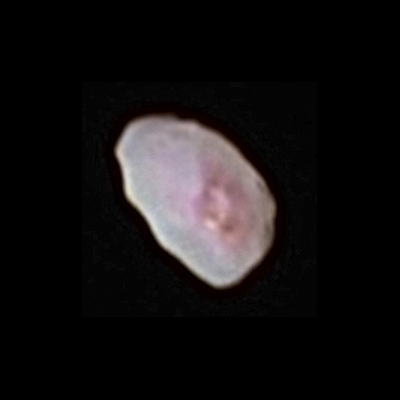
And crescent Nix

And here is Hydra
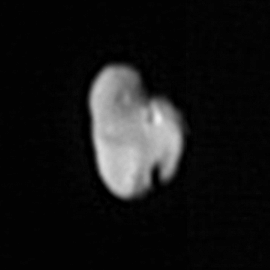
And we have a very fuzzy picture of tiny Styx. Dimensions 7 km by 5 km approx.
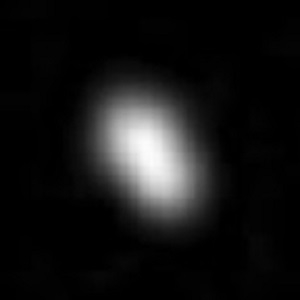
But no moonlets there. Some speculate that because of its complex shape, Hydra might possibly be a double lobe object, like Comet 67p, perhaps formed by a low speed collision of two smaller moons.
The biggest surprise is just that. No moonlets, no rings, nothing else, so far anyway. And they searched pretty thoroughly before the encounter to make sure New Horizons wasn't on target to hit anything. This search was sensitive enough to find moons fifteen times fainter than Styx. So it doesn't seem likely it has any unseen moons of any size, at least.
In detail,
"For a Charon-like albedo of 0.38, diameter upper limits for undetected moons, determined by recovering model test objects implanted in the images, were 4.5 km at 110,000 to 180,000 km from Pluto, 2.4 km at 50,000 to 110,000 km from Pluto, 1.5 km at 19,000 to 50,000 km from Pluto (Charon is 19,600 km from Pluto), and 2.0 km at 5000 to 19,000 km from Pluto. No rings were found at an I/F upper limit of 1.0 × 10-7"
The Pluto system: Initial results from its exploration by New Horizons
BUT ONE BINARY MOON, KERBEROS
They've just imaged Kerberos. It was a big surprise. they thought it was dark - to the extent, was a puzzle how it could be so dark. But turns out it is bright, and probably a "contact binary" like comet 67P.
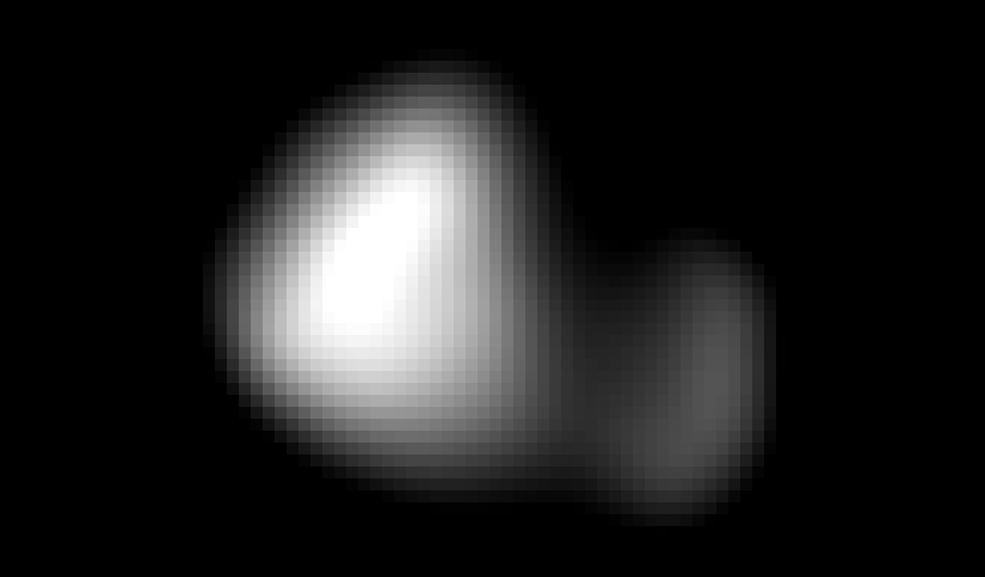
New Horizons image of Kerberos. Its brightness is puzzling as on the face of it, it would seem to imply that it is absurdly dense, far denser than an iron meteorite, many times denser than lead. So, that's denser even than platinum. Perhaps there is something not taken account of in the gravity calculations as the author of the original paper that predicted a dark Kerberos has suggested.
Anyway, whatever it is made of, it looks like a contact binary, so far.
If so, I think this is our first contact binary moon in the solar system. There are plenty of double contact asteroids, and we now know of one comet, but this may be the first contact binary moon.
So though not a moonlet of a moon, or a ring, it's the next best thing... :).
NEW HORIZON'S EXTENDED MISSION TARGET.
Its extended mission target is 2014 MU69, a 45 kilometer diameter near circular orbit "classical Kuiper belt object" which has probably been in the same orbit since the early days of the solar system. An interesting target. But no known moons, so far anyway.
DOUBLE MOONLETS
What about double moonlets, a pair of moonlets both around the same size as each other?
Some binary asteroids consists of two bodies the same size more or less, (so we will have to call them both moonlets).
This is an artist's impression of the binary asteroid 90 Antiope.
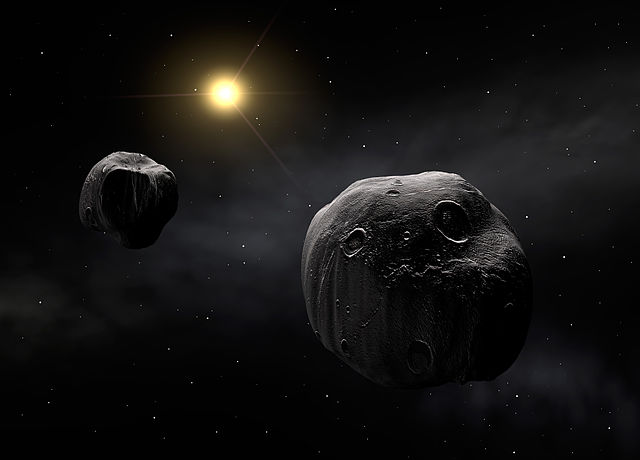
Artist's impression of the double asteroid Antiope produced by European Southern Observatory (ESO).
Adaptive optics image of 90 Antiope taken by the W. M. Keck Observatory in 2000
Double asteroids can also be much smaller. Here are
Radar images of 1937 UB (Hermes) taken in 2013
This time the two moonlets are a really tiny 300–450 meters. (Since neither is noticeably bigger than the other I think have to call them both moonlets).
And the separation of the two is only 1200 meters (1.2 km).
Double asteroids are rare. But about 15% of the Near Earth asteroids are binary (an asteroid with a smaller moonlet).
Various mechanisms have been suggested, and - they seem like processes that could also apply to moons with a large Hill sphere, if there are other objects around that could hit them. For instance, major impacts with an asteroid where the main body breaks apart into several parts, which then collect together to make several bodies in place of the original single body. Or an impact that doesn't break the body apart completely but ejects enough material from a crater so that some of it in the cloud of material created gathers together to form a single moon that ends up in orbit around it. See this paper on Binary and Multiple systems of asteroids.
So again, by analogy with asteroids that often have moonlets, Pluto with its complex moon system, and situation where it is subject to high velocity incoming debris from material in the Kuiper belt, perhaps I can venture a wild speculation, just for fun, that Horizons might find a double moon or a moon with a moonlet :).
Perhaps it may spot a tiny moonlet of Charon - or else - that one of the outermost moons is a binary moon.
It is just a fun idea :). I haven't seen any speculations about this either way. Do say if you know of anything about this possibility. Is there anything that makes it unlikely?
UPDATE - NO PLUTO MOONLETS FOUND
As most of you will know, New Horizons didn't find any double moons or moonlets, not yet anyway. Except that Keberos is possibly a binary contact moon.
But there are lots of other Kuiper belt objects out there, and then the entire Oort cloud to explore as well, eventually. And even the gas giants are not explored so thoroughly you can rule out tiny moonlets of the moons.
What do you think, do you think there is a chance that some of the moons in our solar system, such as Saturn's Rhea, or Iapetus, or Uranus' Oberon, might have undiscovered moonlets or rings? Tiny moonlets or very faint rings? What about the Oort cloud and Kuiper belt - might they have moonlets or rings of moons?
NEW HORIZON'S EXTENDED MISSION TARGET.
Its extended mission target is 2014 MU69, a 45 kilometer diameter near circular orbit "classical Kuiper belt object" which has probably been in the same orbit since the early days of the solar system. An interesting target. But no known moons, so far.
QUORA QUESTION
As usual if you spot any errors in any of this be sure to say, or anything that needs to be corrected. Thanks.
From my answer to the Quora question, "Do moons have moons"
SIMPLE QUESTIONS - SURPRISING ANSWERS
This is also one of the answers in my new kindle book: Simple Questions - Surprising answers - In Astronomy
You can read it on any device, not just a kindle, and also, read it with the kindle cloud reader in your web browser.
ONLINE POSTS
You might like my other posts on Quora

Robert Walker's posts - on Quora
And here on Science20

Robert Walker's posts on Science20
KINDLE BOOKSHELF ON MY AUTHOR'S PAGE
And I have many other booklets on my kindle bookshelf





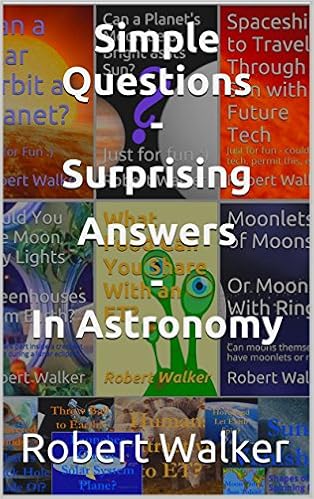




Comments